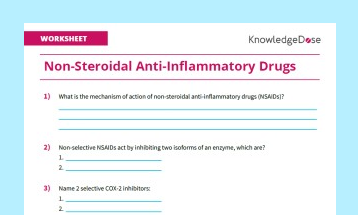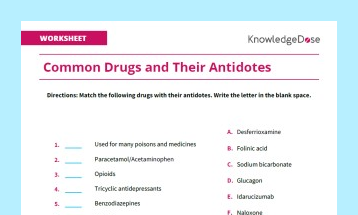Welcome to the drug allergy and cross-reactivity category for physicians and pharmacists. This section features links to clinical practice resources on managing drug allergies and cross-reactivity reactions to drugs such as penicillins, cephalosporins, sulfonamides, NSAIDs and opioids.
British Society for Allergy and Clinical Immunology guidelines for the management of drug allergy
- Source: bsaci.org
- Clinical Resource: Guideline
- Register to Access Content: No
Practical Guidance for the Evaluation and Management of Drug Hypersensitivity: Specific Drugs
From the American Academy of Allergy, Asthma & Immunology and the American College of Allergy, Asthma and Immunology.
- Source: aaaai.org
- Clinical Resource: Practice Report
- Register to Access Content: No
Drug Allergy: A 2022 Practice Parameter Update
From the American Academy of Allergy, Asthma & Immunology and the American College of Allergy, Asthma and Immunology.
This practice parameter provides an updated approach to the
diagnosis and management of various drug reactions.
- Source: aaaai.org
- Clinical Resource: Practice Parameter
- Register to Access Content: No
This guideline covers diagnosing and managing drug allergy in all age groups. It aims to make it easier for professionals to tell when someone is having an allergic reaction, by specifying the key signs and patterns to look out for. It also makes recommendations on improving people’s understanding of their drug allergies, and ensuring these are recorded properly in their medical records.
- Source: nice.org.uk
- Clinical Resource: Guidance
- Register to Access Content: No
Drug Allergies
Adverse drug reactions (ADRs) are broadly divided into predictable (related to pharmacologic actions of the drug in otherwise normal individuals) and unpredictable reactions (related to individual’s immunological response and, on occasion, to genetic differences in susceptible patients).
The term “drug hypersensitivity” refers to objectively reproducible symptoms or signs initiated by exposure to a drug at a dose normally tolerated by non-hypersensitive persons. It is a type of unpredictable ADR and includes reactions induced by immune or inflammatory cells as well as other non-immunological mechanisms. The term “drug allergy” refers to a specific immunologically mediated drug hypersensitivity reaction (DHRs).
- Source: worldallergy.org
- Clinical Resource: Summary
- Register to Access Content: No
Drug (Medication) Allergy
- Action Plan and Record for Drug Allergy
- Penicillin Allergy Resources
- Cephalasoprin Allergy Resources
- Drug Allergy Resources
- Source: allergy.org.au
- Clinical Resource: Summary
- Register to Access Content: Yes – some parts can only be accessed by members
How to Define and Manage Low-Risk Drug Allergy Labels
This article will describe low-risk drug allergy labels, focusing on β-lactam and sulfonamide antibiotics, nonsteroidal anti-inflammatory drugs, iodinated contrast media, and common chemotherapeutics. This review will also address practical management approaches using currently available risk stratification and clinical decision tools.
- Source: jaci-inpractice.org
- Clinical Resource: Journal Article
- Register to Access Content: No
European Academy of Allergy and Clinical Immunology/European Network for drug allergy position paper on drug provocation testing
This position paper provides general recommendations and guidance on optimizing use of drug provocation testing, whilst balancing benefits with patient safety and optimizing the use of the limited available resources.
- Source: eaaci.org
- Clinical Resource: Position Paper
- Register to Access Content: No
- Source: bsaci.org
- Clinical Resource: Guideline
- Register to Access Content: No
Cross-reactivity of beta-lactam antibiotics
The purpose of this paper is to discuss the available data concerning the safety of administering cephalosporins, carbapenems,
and monobactams to penicillin-allergic patients.
- Source: bswhealth.med
- Clinical Resource: Journal Article
- Register to Access Content: No
Penicillin allergy cross-reactivity
- Roughly 10% of the population report allergy to penicillin
- Penicillin is a beta-lactam antibiotic and can therefore cross-react with other beta-lactam antibiotics
- Source: med.umkc.edu
- Clinical Resource: Reference Material
- Register to Access Content: No
“Sulfur allergy”
The term “sulfur allergy” is confusing and may lead to patients believing that they are allergic to all sulfur-containing medications or preservatives, and even to sulfur, an important building block of life. We are often asked, “Can a patient with a sulfur allergy have medication containing sulfur?” and, “What other drugs is the patient likely to be allergic to?” The aim of this bulletin is to clarify the term “sulfur allergy” and the allergies sometimes grouped together under this mantle; sulfonamide, sulfite and sulfate allergies.
- Source: medicinesinformation.co.nz
- Clinical Resource: Drug Information Service Bulletin
- Register to Access Content: No
‘Sulfur allergy’ label is misleading
The term ‘sulfur allergy’ is misleading and dangerous and should not be used. an allergy to a sulfonamide antibiotic may imply cross-reactivity with other sulfonamide antibiotics, but does not imply cross-reactivity with non-antibiotic sulfonamides or other drugs containing sulfhydryl or sulfate groups.
- Source: nps.org.au
- Clinical Resource: Journal Article
- Register to Access Content: No
Hypersensitivity reactions to proton pump inhibitors. An European Academy of Allergy and Clinical Immunology position paper
In this Position Paper, we provide clinicians with practical evidence-based recommendations for the diagnosis and management of HSRs to PPIs. Furthermore, the unmet needs proposed in the document aim to stimulate more in-depth investigations in the topic.
- Source: eaaci.org
- Clinical Resource: Position Paper
- Register to Access Content: No
Opioid Allergic Reactions
Patient reports of opioid “allergies” are common, most often due to symptoms of nausea, vomiting, itching, hypotension, or constipation. This Fast Fact will review signs, symptoms, and management options of opioid allergies and pseudo-allergies.
- Source: mypcnow.org
- Clinical Resource: Summary
- Register to Access Content: No
Opioid Allergies and Cross-reactivity
How many times have you had a patient with an allergy to codeine described as stomach upset? Or how about a rash with morphine (probably secondary to histamine release)?
- Source: umem.org
- Clinical Resource: Educational Pearl
- Register to Access Content: No
The aim of this review prepared by a group of experts representing the EAACI/ENDA group and GA2LEN Network of Excellence is to present up-to-date information on the pathomechanisms and clinical spectrum of hypersensitivity reactions caused by NSAIDs. Additionally, practical recommendations for proper diagnosis and management of patients with NSAIDs hypersensitivity are proposed.
- Source: ga2len.net
- Clinical Resource: Review Article
- Register to Access Content: No
- Source: uic.edu
- Clinical Resource: Frequently Asked Question
- Register to Access Content: No
‘Iodine allergy’ label is misleading
‘Iodine allergy’ is not an accurate label for patients who have had allergic reactions to iodinated radiological contrast media or iodinated antiseptics. Allergy to seafood has nothing to do with iodine content as it is caused by specific immunoglobulin E to proteins.
- Source: nps.org.au
- Clinical Resource: Journal Article
- Register to Access Content: No
- Source: bsaci.org
- Clinical Resource: Guideline
- Register to Access Content: No
Perioperative Allergic Reactions
Anesthesia represents a pharmacologically unique situation, during which patients are exposed to multiple foreign substances including anesthetics, analgesics, antibiotics, antiseptics, blood products, heparin, polypeptides, and intravascular volume expanders, which can produce immediate hypersensitivity reactions or anaphylaxis.
Since no preemptive therapeutic strategies exist, both vigilance of the attending clinicians to rapidly recognize and treat these reactions and subsequent allergological investigations to identify the offending agent and prevent recurrences, are of critical importance.
- Source: worldallergy.org
- Clinical Resource: Summary
- Register to Access Content: No
How should allergic reactions to local anesthetics be managed?
- Source: uic.edu
- Clinical Resource: Frequently Asked Question
- Register to Access Content: No
Hypersensitivity reactions to chemotherapy: an European Academy of Allergy and Clinical Immunology position paper
This position paper aims to provide consensus on the investigation of HSRs to chemotherapeutic drugs and give practical recommendations for clinicians that treat these patients, such as oncologists, allergologists and internists.
- Source: eaaci.org
- Clinical Resource: Position Paper
- Register to Access Content: No
Hypersensitivity reactions to biological agents: An European Academy of Allergy and Clinical Immunology position paper
In this Position Paper, the authors will provide evidence-based recommendations for diagnosing and managing hypersensitivity reactions to biologicals.
- Source: eaaci.org
- Clinical Resource: Position Paper
- Register to Access Content: No
European Academy of Allergy and Clinical Immunology position paper on how to classify cutaneous manifestations of drug hypersensitivity
Drug hypersensitivity reactions (DHRs) are common, and the skin is by far the most frequently involved organ with a broad spectrum of reaction types. The diagnosis of cutaneous DHRs (CDHR) may be difficult because of multiple differential diagnoses. A correct classification is important for the correct diagnosis and management. With these guidelines, we aim to give precise definitions and provide the background needed for doctors to correctly classify CDHR.
- Source: eaaci.org
- Clinical Resource: Position Paper
- Register to Access Content: No
Pharmaceutical excipients – where do we begin?
Excipients have been defined in many ways, including as inert substances used as vehicles and diluents for drugs. The problem with this definition is that in recent years excipients have proved to be anything but inert, not only possessing the ability to react with other ingredients in the formulation, but also to cause adverse and hypersensitivity reactions in patients.
- Source: nps.org.au
- Clinical Resource: Journal Article
- Register to Access Content: No
Resources last checked: 15/07/2024



